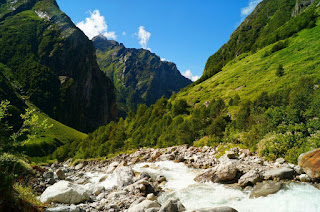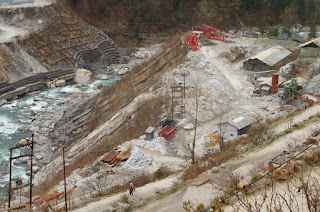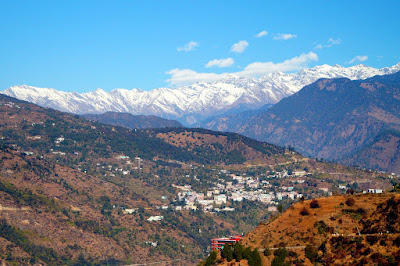There is a reason why well-kept gardens are so salubrious to
the mind and soul of living beings. Swathed in variegated shades of green and offering
respite from the polluted environment of our cities, gardens and similar
landscapes allures everyone to spend time. But there is a limit to such expanses
in cities. One usually has to escape the bounds of the cities to find larger
and more pristine environment. Our protected areas offer us the desired solace.
It is always an invigorating feeling in such habitations. My visit to the
Valley of Flowers in Uttarakhand stirs in me similar feelings.
The Valley of Flowers National park is open only for nearly
four months in a year from June to September. Mid-July to mid-August is said to
be the time when the glory of the national park is at its acme as the myriad
flowers, which are the USP of the park, are at their full glamour. A group of
seven, Bilal, Dinesh, Gaurav, Nishant, Paritosh, Suryakant and Utkarsh, belonging
to six different states of India got together for the trek. It was quite a task
to bring everyone on board. We had planned to visit VOF around August 15 but the
monsoon rain was, as usual, battering the state with immense downpour around this
time. Occurrences of landslides were commonplace. Finally keeping aside the
risk, we went ahead with our plan with a couple of days as buffer for any
hindrance in the trip.
 Since Utkarsh was to join from Haridwar the next morning, the
six of us left from Delhi at midnight on August 12 from Kashmiri Gate bus
station, taking a bus to Haridwar. The Delhi station was teeming with tourists.
We missed at least 5 buses until we found one with seats for the 6 of us. That
bus broke down at Roorkee, an hour short of Haridwar. Luckily another bus was
arranged in no time. But it had taken us nearly 6 hours for a 5 hour journey by
bus and we reached just before 6 am.
Since Utkarsh was to join from Haridwar the next morning, the
six of us left from Delhi at midnight on August 12 from Kashmiri Gate bus
station, taking a bus to Haridwar. The Delhi station was teeming with tourists.
We missed at least 5 buses until we found one with seats for the 6 of us. That
bus broke down at Roorkee, an hour short of Haridwar. Luckily another bus was
arranged in no time. But it had taken us nearly 6 hours for a 5 hour journey by
bus and we reached just before 6 am.
August 13: Utkarsh was waiting for us at the bus station. He
had enquired with the taxi union for the road ahead. We booked a taxi (Tata
Sumo) from the taxi union stand just outside the Haridwar bus stand till
Govindghat for INR 6550 and buckled up for another long leg of the journey. After
having our usual bun-makhhan breakfast at Haridwar bus station along with a cup
of tea at 7 am, the journey began. Together, we all felt pleased and excited
for the journey. It was Suryakant’s first visit to the mountains and on certain
occasions I thought he would jump out of the vehicle to take a wholesome view
of the sprawling natural beauty. The windowpanes were small enough though. Sitting
at the back of the vehicle was dizzying and whoever sat there felt like
vomiting, so we kept switching places.
 We did make several pit stops before we reached Pandukeshwar,
1.5 km ahead of Govindghat, at 5:30 pm. We lodged ourselves in two rooms at
Pandukeshwar for INR 800 for the night with hot water costing dearly at INR 40
per bucket. It was getting dark and the valley looked formidable in the rains
that followed. We freshened up and left to have dinner. A chat with locals
helped clarify our doubts and concerns about the VOF. They mentioned that while
the trek till Ghangharia (base camp for VOF and Hemkund Sahib) is 14 km long,
one can take a taxi from Pandukeshwar to Pulna, from where the trek is only 11
km. A helicopter service is also available from Govindghat to Ghangharia that
would curtail the 5 hour journey to 5 minutes but we were all set to embark on the
trek the next morning.
We did make several pit stops before we reached Pandukeshwar,
1.5 km ahead of Govindghat, at 5:30 pm. We lodged ourselves in two rooms at
Pandukeshwar for INR 800 for the night with hot water costing dearly at INR 40
per bucket. It was getting dark and the valley looked formidable in the rains
that followed. We freshened up and left to have dinner. A chat with locals
helped clarify our doubts and concerns about the VOF. They mentioned that while
the trek till Ghangharia (base camp for VOF and Hemkund Sahib) is 14 km long,
one can take a taxi from Pandukeshwar to Pulna, from where the trek is only 11
km. A helicopter service is also available from Govindghat to Ghangharia that
would curtail the 5 hour journey to 5 minutes but we were all set to embark on the
trek the next morning. August 14: It was raining when we marched ahead the next morning at 6:30 am. We hired a taxi from Pandukeshwar to Pulna for 4.5 km; it
dropped us at Pulna for INR 400 within half an hour. Considering one also has to
carry one’s luggage till Ghangharia, it was a good decision to take the taxi
till Pulna. It not only saves significant effort but it does save a lot of
time. One can buy make-do raincoats and small bags for low prices at Pulna. Our
trek to Ghangharia began from here. We wore our raincoats/ ponchos to keep the
light drizzle at bay. We also
August 14: It was raining when we marched ahead the next morning at 6:30 am. We hired a taxi from Pandukeshwar to Pulna for 4.5 km; it
dropped us at Pulna for INR 400 within half an hour. Considering one also has to
carry one’s luggage till Ghangharia, it was a good decision to take the taxi
till Pulna. It not only saves significant effort but it does save a lot of
time. One can buy make-do raincoats and small bags for low prices at Pulna. Our
trek to Ghangharia began from here. We wore our raincoats/ ponchos to keep the
light drizzle at bay. We also
donned our winter-wear as it was cold outside. Clicking
photographs and taking selfies on the way, we moved forward with little
difficulty. Suryakant, however, started showing signs of weariness in the
initial kilometre itself. First he handed over his luggage to Dinesh and kept
pace. Later, we put his luggage on a mule and he somehow managed to walk
through the rest of the trek.
 The hills offer amazing vistas and panoramas, from thick
forests to open ridges with cascade of waterfalls. There are shops after regular
intervals where one can eat, drink and catch a breath. But as one gains
altitude, things start getting costlier for valid reason. The last stretch of
around 4 km takes a toll and tests trekkers. We pulled ourselves together and
reached Ghangharia at around 12 pm after an arduous trek of nearly 11 km. Many
tourists had already flocked Ghangharia. We looked for hotels and got two rooms
in two separate hotels. We were really tired and didn’t look further to get
rooms in the same hotel. We all met for lunch again. Ghangharia is a small place
meant to house tourists for the treks to the VOF and Hemkund Sahib (HS). A lot
of tourists, mostly Sikhs, make a pilgrimage to HS. Two separate routes go to
VOF and HS and one can’t and shouldn’t cover both the places in the same day. For
us, VOF was the priority.
The hills offer amazing vistas and panoramas, from thick
forests to open ridges with cascade of waterfalls. There are shops after regular
intervals where one can eat, drink and catch a breath. But as one gains
altitude, things start getting costlier for valid reason. The last stretch of
around 4 km takes a toll and tests trekkers. We pulled ourselves together and
reached Ghangharia at around 12 pm after an arduous trek of nearly 11 km. Many
tourists had already flocked Ghangharia. We looked for hotels and got two rooms
in two separate hotels. We were really tired and didn’t look further to get
rooms in the same hotel. We all met for lunch again. Ghangharia is a small place
meant to house tourists for the treks to the VOF and Hemkund Sahib (HS). A lot
of tourists, mostly Sikhs, make a pilgrimage to HS. Two separate routes go to
VOF and HS and one can’t and shouldn’t cover both the places in the same day. For
us, VOF was the priority.
We had plenty of time after lunch and wondered if we should
start trekking the VOF once today. But we chose not to as the VOF closes at 5
pm and then there was always the fear of rains getting harder. We rather decided
to explore Ghangharia. In addition to housing several guest houses and
restaurants, the place also houses a few medicine shops and a couple of
clinics. During our exploration of Ghangharia, we got a chance to meet Mr. Raviraj
Chauhan, who has been guiding tourists for more than 15 years in VOF and the
surrounding areas. He was enthralled to interact with youngsters like us and
describe the magnificence of the VOF’s flora and fauna. He showed us his prized
collection of photographs of various terrestrial and avian fauna. He shared the
plight of the environment around the VOF due to climatic disturbances,
something which we also strongly believed. We bid goodbye as we left him to
cater to his customers. Gaurav, Dinesh and I then climbed down to a waterfall,
where I soaked my shoes but managed to take beautiful photographs.
August 15: What a morning! India’s Independence Day. Nestled
in the hills, we felt independent ourselves. Gaurav, Bilal and I vacated our
room. We all had a mediocre breakfast, packed parathas for lunch and left for
the days’ trek to VOF at around 7 am. The park opens at around 7 am and we were
there by 7:30 am. The VOF National Park (NP) is spread in 87.50 sq. km and as
mentioned by one of the guards at the entrance of the NP, the trek within the
park goes as far as 10-11 km. If one is planning to go that far in a single day,
one must begin early with food packed for the long journey, as no food is available
once one enters the NP. Indian citizens have to pay INR 150 on entering the NP,
which is the cost for 3 days. We entered along with several other tourists to
the NP. There is clearly marked trail and it passes through thickets,
undergrowth, open areas, large trees and a number of waterfalls. Later that day
we would get to know that this was the day when the NP received the highest footfall
ever, 362 tourists visited VOF in just one day.
I had caught severe cold. One of my hands was taking
photographs while the other was carrying a hankie serving my running nose. Bilal
and Suryakant too were not very comfortable. But the magnificence of the place
kept everyone going. Suryakant went back after some 4 km. The rest of us
carried on further till we reached the Pushpawati River flowing in wide open
area. The time was still
11: 30 am and it had just started to drizzle again. We
could see the clouds enshrouding the valley just above us and the biting wind
blew. We celebrated the insurmountable beauty of the valley taking lunch
together. We silently ruminated over the spirit of the valley in the backdrop
of the majestic Pushpawati River which bifurcated the resplendent flora in the
foreground and the verdant mountains & cascading waterfalls in the background.
Dinesh, Gaurav, Paritosh and Utkarsh continued further while Bilal and I
decided to go back.
We saw a lot of people still climbing on our way back. Bilal
and I climbed down and headed straight to have some tea and Maggi. We also booked
another room, since we had left our previous room in the morning. We found a
room close to the other room and booked it for INR 400. Signs of weariness were
visible on everyone’s face when they came back. But the sense of achievement was
more overpowering. Tiredness soon took over and everyone slept after a short
while. After the exhausting journey, some people offer leg massage at
a cost of INR 50-100. One such person also took Paritosh’s and my shoes to dry
out. While the cost is high (INR 150 per pair to dry), you do need dry shoes. Others
went for leg massages. We discussed the plan for tomorrow at dinner. Nobody
seemed to come to consensus on going to HS, but it was anyways decided to trek
to HS the next morning at 7 am.
16 August: It was raining incessantly. Paritosh and Gaurav
were still sleeping. I too was never feeling well after that cold and I asked
others to trek HS without me. But others also backed out. We thought it was
better to climb down from Ghangharia to Govindghat. Within an hour and a half,
everyone had had their breakfast and was ready to descend. We began the descent
in the downpour and it almost never ceased completely even by the time we
reached Pulna. We hired a cab till Joshimath and it took us there in an hour.
From Joshimath we again hired a cab till Haridwar for INR 5500 and were there
by 10 pm. We then had a sumptuous dinner and settled our accounts. It was just
before 12 by that time. Dinesh and Suryakant stayed at Haridwar as they wanted
to visit Rishikesh again while the five of us left for Delhi seeing an AC bus calling
for passengers to Delhi. We reached Delhi by 5 am on 17th August. INR 4000 was enough to
see through the journey.
Since we had 4 more days of holidays, Bilal, Gaurav and I
left for Pushkar, Ajmer and Jaipur on 18th, which is another story
for some other time.





























